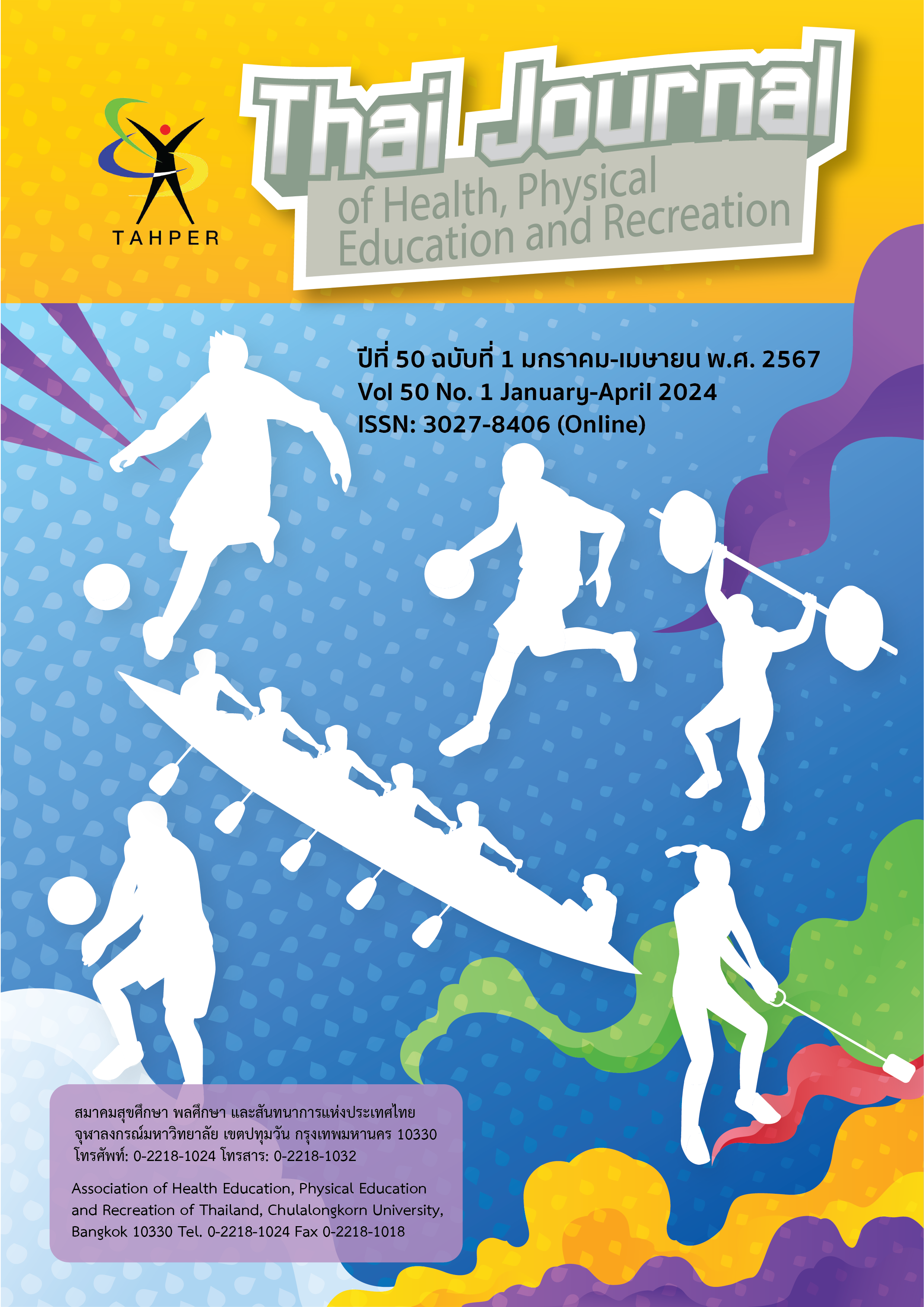The Effects of Circuit Training Program on Health-Related Physical Fitness for Secondary School Students at Watchotikaram School
Main Article Content
Abstract
The study aimed 1) to compare the effects of the circuit training program on health-related physical fitness between the experimental group and the control group, 2) to compare the effects of the circuit training program on health-related physical fitness between males and females, and 3) to compare the effects of health-related physical fitness after week 4 and week 8. The samples in the study included 44 secondary school students from Watchotikaram School by Multi-Stage Sampling. Research instruments included 1) the circuit training program developed by the researcher 2) a physical fitness test by the Sport Science Bureau, Department of Physical Education, Ministry of Tourism and Sports. Regarding research methodology, the data were collected by the experimental group for 8 weeks and 3 days a week, which are Monday, Wednesday, and Friday. The practice began from 3:30 p.m. to 4:30 p.m. Health-related physical fitness was tested at 3-time intervals, namely before training, after week 4, and week 8. The results of the pre-training physical fitness test were used as a covariant in the research. Statistics for data analysis included mean, standard deviation, Three-way analysis of covariance with repeated measures, Two-way analysis of covariance with repeated measures, and Tukey’s Pairwise Mean Comparisons.
Results
1. Health-related physical fitness between the experimental group and the control group found that the body mass index: BMI, sit and reach, 30 seconds modified push ups, and 3 minutes step up and down had no difference while 60-second sit-up had a statistically significant difference of 0.05 2. Health-related physical fitness between males and females found that the body mass index: BMI, sit and reach, 30 seconds modified push ups, 60-second sit-ups, and 3 minutes step up and down had no difference. 3. Health-related physical fitness after week 4 and week 8 found that the body mass index: BMI had no difference sit and reach, 30 seconds modified push ups, 60-second sit-ups, and 3 minutes step up and down had a statistically significant difference of 0.05.
Article Details

This work is licensed under a Creative Commons Attribution-NonCommercial-NoDerivatives 4.0 International License.
Critical thinking in journals is the right of the author. The Association of Health Education, Physical Education and Recreation of Thailand is not always required, to create diversity in ideas and creativity.
ความคิด ข้อวิพากษ์ในวารสารเป้นสิทธิของผู้เขียน สมาคมสุขศึกษา พลศึกษา และสันทนาการแห่งประเทศไทยไม่จำเป็นต้องเห็นชอบด้วยเสมอไป เพื่อให้เกิดความหลากหลายในความคิดและความสร้างสรรค์
References
กรมพลศึกษา กระทรวงศึกษาธิการ. (2543). กิจกรรมการทดสอบและสร้างเสริมสมรรถภาพทางกาย. กรุงเทพมหานคร: สำนักพัฒนากรมพลศึกษา สุขภาพและนันทนาการ.
กระทรวงศึกษาธิการ. (2551). ตัวชี้วัดและสาระการเรียนรู้สุขศึกษาและพลศึกษา หลักสูตรแกนกลางขั้นพื้นฐาน พุทธศักราช (2551). กรุงเทพมหานคร: โรงพิมพ์ชุมชนสหกรณ์การเกษตรแห่งประเทศไทย จำกัด.
เจริญ กระบวนรัตน์. (2561). การออกแบบโปรแกรมที่มีประสิทธิภาพสำหรับเด็ก. วารสารสุขศึกษา พลศึกษา และสันทนาการ, 44(2), 7.
พรสุข หุ่นนิรันดร์, ประภาเพ็ญ สุวรรณ, สุริย์พันธุ์ วรพงศธร และอนันต์ มาลารัตน์. (2562). หนังสือเรียนรายวิชาพื้นฐาน สุขศึกษา ม.2. กรุงเทพมหานคร: บริษัท อักษรเจริญทัศน์ อจท. จำกัด.
เรืองวัฒน์ ประทุมอ่อน. (2559). ผลของโปรแกรมกิจกรรมทางกายที่มีต่อสมรรถภาพทางกายเพื่อสุขภาพของนักเรียนมัธยมศึกษาปีที่ 3 โรงเรียนโพนทองพัฒนาวิทยา. วิทยานิพนธ์ศิลปศาสตรมหาบัณทิต สาขาพลศึกษา, มหาวิทยาลัยเกษตรศาสตร์.
สมหมาย แตงสกุล,เชาวลิต ภูมิภาค และวิชุดา คงสุทธิ์. (ม.ป.ป.). หนังสือเรียนรายวิชาพื้นฐาน สุขศึกษาและพลศึกษา ม.2. กรุงเทพมหานคร: บริษัท สำนักพิมพ์วัฒนาพานิช จำกัด.
สุภัทรชัย สุนทรวิภาต. (2565). ผลของโปรแกรมการออกกําลังกายแบบสถานีที่มีต่อความอดทนของระบบไหลเวียนเลือดและระบบหายใจของนักเรียนหญิงระดับชั้นประถมศึกษาปีที่ 6 โรงเรียนสาธิตแห่งมหาวิทยาลัยเกษตรศาสตร์ศูนย์วิจัยและพัฒนาการศึกษา. วารสารสุขศึกษาพลศึกษาและสันทนาการ, 45(1), 120-139.
สำนักวิทยาศาสตร์การกีฬา. (2562). แบบทดสอบและเกณฑ์มาตรฐานสมรรถภาพทางกายของนักเรียน ระดับมัธยมศึกษา (อายุ 13-18 ปี). กรุงเทพมหานคร: กรมพลศึกษา กระทรวงการท่องเที่ยวและกีฬา.


